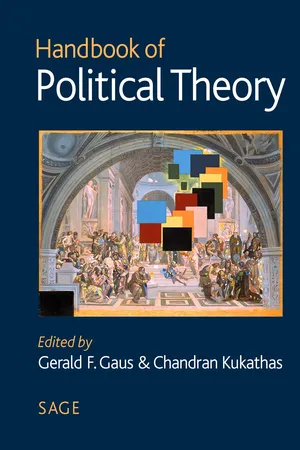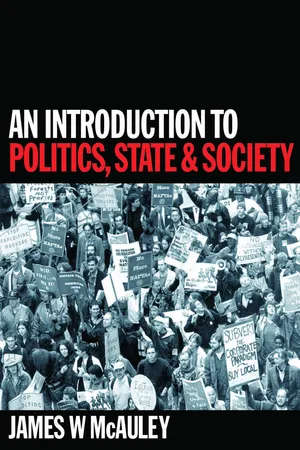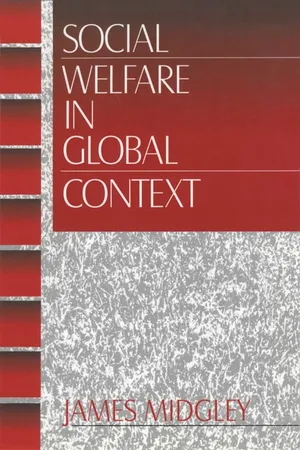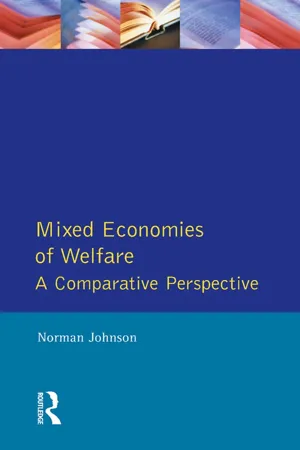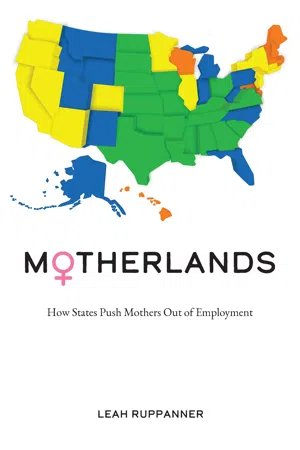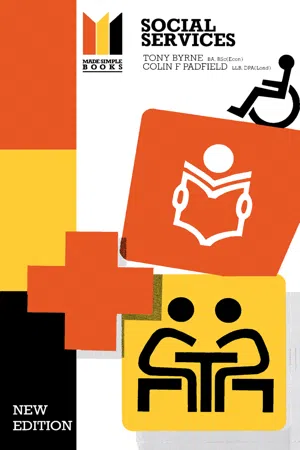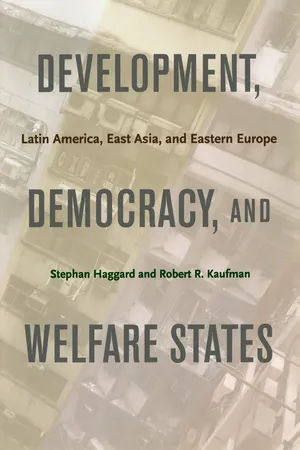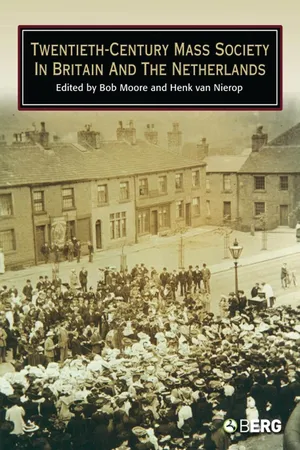History
The Welfare State
The welfare state refers to a system in which the government takes responsibility for the social and economic well-being of its citizens. It typically involves providing social services such as healthcare, education, unemployment benefits, and pensions. The concept gained prominence in the 20th century as a response to the challenges of industrialization, urbanization, and social inequality.
Written by Perlego with AI-assistance
Related key terms
1 of 5
11 Key excerpts on "The Welfare State"
- Available until 27 Jan |Learn more
Democracy and the Welfare State
The Two Wests in the Age of Austerity
- Alice Kessler-Harris, Maurizio Vaudagna, Alice Kessler-Harris, Maurizio Vaudagna(Authors)
- 2017(Publication Date)
- Columbia University Press(Publisher)
CHAPTER ONE Historians Interpret The Welfare State, 1975–1995 MAURIZIO VAUDAGNA SOCIAL SCIENTISTS AND HISTORIANS WRITE THE HISTORY OF The Welfare StateAfter more than a half-century of modern social policies, World War II ushered in an era that witnessed the marriage of Keynesian economics and social security.1 The notion of the “welfare state” emerged as a political, social, and economic order where the state played a key role in protecting and promoting the economic and social well-being of its citizens. Its definition fell within two clusters of meaning: on the one hand, The Welfare State was a “mixed system” of public/private economic cooperation that fostered a policy of growth and full employment and, on the other, it promised a protective policy of socioeconomic security. As a result, the idea of justice expanded to include new meanings: “social justice” and “social rights” became qualities of democratic citizenship as essential to the individual as civil, personal, and political rights.After World War II, historicist social scientists initiated and went on to dominate the field of social policy and welfare-state history. For the most part, they interpreted that history with a pronounced presentist vision of the past. Founded by the British public intellectual Richard Titmuss, the social-science approach aimed to explain the links connecting “modernization,” liberal democracy, and social provision.2 The egalitarian wartime social services, Titmuss argued, reflected the sense of solidarity held by families and communities, fed the principle of equal citizenship, and powerfully contributed to the victory of freedom.Titmuss inaugurated a trend in social scientists’ historical explorations of The Welfare State that has continued to this day. Endless examples could be cited. For example, since the 1960s the Swedish sociologist Walter Korpi has embraced a neo-Marxist interpretation of the democratic class struggle as the core of the social-democratic welfare state.3 In 1971, the American economist Gaston Rimlinger published a comprehensive study of the historical traditions that had originated different transatlantic “paths” to social security.4 Equally comparative was the book published in 1981 by the joint U.S.-German research group led by the sociologists Peter Flora and Arnold J. Heidenheimer.5 Their interpretation joined the substantial ranks of publications by scholars who thought of The Welfare State as a functional necessity of modern liberal capitalism. In particular, Flora and Heidenheimer focused on the social state as “an answer to increasing demands for socioeconomic equality in the context of the evolution of mass democracies.”6 - eBook - PDF
- Gerald F Gaus, Chandran Kukathas, Gerald F Gaus, Chandran Kukathas(Authors)
- 2004(Publication Date)
- SAGE Publications Ltd(Publisher)
16 The Political Theory of The Welfare State J . D O N A L D M O O N The term ‘The Welfare State’ came into common usage in the middle of the twentieth century. Its use reflected the growth in Western democracies of governmental responsibility for, and programmes addressing, an extensive range of human needs, such as education, health care, housing, child care, and economic security for the elderly, the unem-ployed, and the disabled. Some of the programmes of The Welfare State, such as public schools and old age pensions, were first developed in the nineteenth century, but what might be called the ‘institutional’ welfare state did not fully emerge until after World War II, when most democratic countries adopted a more or less integrated range of programmes of welfare provision and policies of economic man-agement. The institutional welfare state is character-ized by a range of programmes designed to meet different needs and to provide security against various contingencies. Depending upon what ‘cate-gory’ one falls into, one would be eligible for differ-ent types of benefits. Thus, elderly people would be eligible for pensions, sick people for sickness bene-fits and health care, unemployed people for unem-ployment compensation, young people and those without marketable skills for education or job train-ing, etc. At least as an ideal, as Brian Barry (1990) points out, the institutional welfare state would not even require a general safety net, since specialized programmes would cover all of the different condi-tions that prevent people from meeting their needs. In reality, of course, there will always be some who fall between the cracks, and so The Welfare State must have a programme of ‘social assistance’ to cover residual cases. The emergence of the institutional welfare state is reflected in the enormous growth of government expenditures to finance its programmes, both in absolute terms and in relation to national income. - James W McAuley(Author)
- 2003(Publication Date)
- SAGE Publications Ltd(Publisher)
The activation of a commitment to social justice and egalitarianism saw the promotion of welfare, which was made overt in a whole series of legislation implemented between 1944 and 1948. This resulted in a much-expanded role for the state in areas such as health, education, housing and social security. Underpinning this, was Beveridge’s commitment to overcome what were termed the ‘five giants of social evil’: want, disease, ignorance, squalor and idleness. Pragmatically, this resulted in the development and expansion of several different ‘welfare departments’, and tiers of government by which it could be managed. The development of state welfare It was these economic and political parameters that directed the development of the British state and the political consensus which emerged over The Welfare State. The core economic foundation for this were the belief in, and a com-mitment to, the notion that a managed economy could deliver near full employment. Importantly, however, despite a commitment to the principle of universal provision, the state was never seen as the only agency supplying welfare services. Underlying The Welfare State was the understanding of continuing provision of welfare by the family and by the private sector. As Clarke and Langan explain: In addition to its direct role in the provision of health care and education, the state was required to support the institutions of the market and the family, filling gaps where the market and family failed, but with no intent to replace them as the main source of support to individuals. In their different ways the programmes of public housing, income maintenance, services to neglected children and so on, assumed the needs would be met primarily through (male) waged work and the services which the wage can buy, and through services provided within the family by wives/mothers.- eBook - PDF
- James Midgley(Author)
- 1997(Publication Date)
- SAGE Publications, Inc(Publisher)
Industrialization, they believed, compelled governments to create extensive social programs. Several writers have attempted to categorize The Welfare State in ideological terms. Some argue that the creation of the Western welfare state represents a historical phase in the development of socialism that differs from the revolutionary Theories of State Welfare 1Q| socialism of Marxism. The Welfare State is a democratic socialist project brought about by the struggles of working-class people to create a just society. As was noted in the last chapter, Richard Titmuss viewed the social services as a socialist enterprise. Similarly, writers such as Walter Korpi (1983), GostaEsping-Andersen (1985), and John Stephens (1979) believe that Western welfare states such as Sweden have significantly modified the capitalist system and are an expression of socialist aspirations. Examining developments in Sweden, Stephens concludes that the country demonstrates that a parliamentary transition to socialism is possible. As will be shown later in this chapter, Esping-Andersen (1990) claims that the Swedish welfare state had significantly decommodified labor. On the other hand, Marxist writers argue that The Welfare State is little more than an attempt to ameliorate the worse excesses of capitalism (Ginsberg, 1979; Gough, 1979; Offe, 1984). They insist that The Welfare State is not even remotely socialist in character. Norman Ginsberg (1992) argues that even in Sweden where The Welfare State is probably most advanced, the economy is owned and controlled by private interests to an astonishing extent (p. 198). It is for this reason that Marxist and other left-wing critics frequently invoke . H. Marshall's (1971) phrase welfare capitalism to describe state social intervention in the Western industrial nations. Some writers take a third position, contending that The Welfare State is a unique social formation. They claim that it is neither socialist nor capitalist. - eBook - ePub
- Norman Johnson(Author)
- 2014(Publication Date)
- Routledge(Publisher)
Chapter 5 .The growth of state intervention
State involvement in welfare goes back several centuries, but The Welfare State as we understand it today can be traced back to the late nineteenth century. Kuhnle (1981, p. 126) states that ‘Most writers trace the initiation of The Welfare State, or at least the beginning of the present stage of development, to Bismarck's large-scale social insurance schemes of the last quarter of the nineteenth century’. Different countries developed services at different rates, at different times and with different priorities.Nevertheless, by 1900 Germany already had sickness insurance, industrial accident insurance and old age pensions. By 1911 every country in Western Europe had some form of workers' compensation scheme. In 1913 Sweden was the first country to introduce a pensions insurance scheme covering the entire population, but by that time Australia, Austria, Belgium, Denmark, France, Germany, Italy, The Netherlands, Norway, Switzerland and Britain all had some form of sickness insurance which financed both cash benefits and some health care services. Membership of the schemes was compulsory for certain categories of workers in Austria, Germany, The Netherlands, Norway and Britain; elsewhere membership was voluntary but with some subsidisation from the state. Unemployment insurance, introduced in Britain in 1911, came later elsewhere; for example, not until 1927 in Germany, not until 1935 in the United States, and not until 1944 in Canada.It would take far too long to chronicle the gradual and fitful development of The Welfare State from the nineteenth century to the present time, and I will now turn to the post-war period when all capitalist countries accepted the principle of The Welfare State, although to different extents and with varying degrees of enthusiasm. The foundations for The Welfare State laid during the sixty years before the outbreak of the Second World War were now consolidated as the range of state provision expanded. The late 1940s saw the beginning of a period of social reform which continued unabated until the end of the 1960s. This period may be considered the heyday of The Welfare State. In the immediate postwar period every capitalist country co-ordinated and extended its social security system, and benefits were increased. In West European countries coverage became increasingly comprehensive and universal. In the United States social security expanded more gradually than it did in Europe, and it was not until the 1960s that provision became a little less selective, and in 1965 Medicaid (for poorer people) and Medicare (for older people) were introduced. Almost everywhere expenditure on health and education rose absolutely and as a proportion of GDP. Housing programmes were launched in most countries, and governments began to take a more active role, through subsidies, loans and allowances. - eBook - PDF
- Philip van Praag(Author)
- 2017(Publication Date)
- Amsterdam University Press(Publisher)
4 The Welfare State under Pressure Franca van Hooren 4.1 Introduction Each child in the Netherlands receives good care from birth on, and can go to a school that is accessible to everyone. When adults lose their jobs or become unable to work, they can rely on a minimum income provision, and after retire-ment they get an old-age pension. The Welfare State provides for individual well-being and opportunities for personal development, and thereby also for social well-being. In countries with a well-developed welfare state, there is less poverty, lower infant mortality and less crime (Wilkinson & Pickett 2009). These provisions come with a price tag. In developed welfare states, about half the government’s budget is spent on social provisions. Because of the high costs and the major societal impact, The Welfare State is continuously the subject of political discussions. Should the retirement age go up? Is it fair to require out of pocket payments in healthcare insurance? Should the government subsidise household help for the elderly? Should fathers have the right to take parental leave? Should a refugee be entitled to social assistance benef its? These are some of the topics that have been on the political agenda in the Netherlands and in other countries in recent years and that sometimes stir up emotional debates in society. This chapter discusses the historical development of, and current issues around, The Welfare State from a political science perspective. First, it of fers a description of what The Welfare State does. This is followed by an overview of dif ferent development trajectories that welfare states took in Europe and North America. It then turns to the reforms and restrictions that started in the 1980s. And finally, it delves into current issues and their political implications. 4.2 What does The Welfare State do? In a welfare state, the government plays an important role in promoting the well-being of its citizens. - eBook - PDF
The End of Welfare as We Know It?
Continuity and Change in Western Welfare State Settings and Practices
- Philipp Sandermann(Author)
- 2014(Publication Date)
- Verlag Barbara Budrich(Publisher)
This is exemplified in the assertion by Milton and Rose Freidman in the early 1980s that “The Soviet Union is the immediate danger perceived by Americans. Yet it is not the real threat to our national security. The real threat is The Welfare State” (Freidman and Freidman, 1984: 73). The idea of the “welfare state” has served as a potent mobilizing symbol for a variety of political projects. It is precisely this murkiness of the term—its multiple po-litical, cultural and normative capacities and valences—that makes it interest-ing. Rather than trying to resolve this diversity of meaning by a more pre-scriptive and “correct” definition of the phrase, I want to treat its instability, flexibility and mobility as significant features worthy of our attention. My starting point then, is to recognize The Welfare State as a variable so-cial construction (historically and nationally). Then we can deconstruct the phrase “welfare state”—and, I will suggest, its conceptual shadow, the na-tion–state—in order to see why it might be hard to categorize and conceptu- 24 John Clarke alize welfare state change or transformation. In these terms, we need to think about The Welfare State as an invention—a political–cultural fiction—an im-aginary (Lewis, 2000). The wide public and academic circulation of the phrase since then suggests that it functions as what Raymond Williams (1976) called a “keyword:” a focus of political and cultural investment and contestation. Here, I want to decompose the phrase into its two terms— welfare and state—to reflect on the problems of their meaning as well as how they have been brought together into such a potent combination with a third term—nation (since welfare states have been imagined as nation–states). Welfare: Welfare is both abstractly elusive and concretely difficult to specify. - eBook - PDF
Motherlands
How States Push Mothers Out of Employment
- Leah Ruppanner(Author)
- 2020(Publication Date)
- Temple University Press(Publisher)
approach to welfare at a federal level (Berkowitz 1991). This ideological approach—that welfare is restricted to the poor rather than universally available—coheres with the American individualist “pull-yourself-up-by-the-bootstraps” ideology and provides the foundation of most federal policies including those aimed at supporting working families. As welfare policies proliferated throughout Western industrial nations during the twentieth century, it became clear that states’ approaches to wel-fare were influenced by their differing social and political cultures. Gosta Esping-Andersen (1990) offered arguably the most influential account of this phenomenon, through his typology of three worlds of welfare. This typology overlaid different nation-states’ welfare policies with analyses of their culture and history, producing three different holistic types of welfare state: liberal, conservative, and social democratic. The liberal welfare state is characterized by limited government interven-tion. When governments provide direct welfare assistance to their citizens, resources are allocated to those in the greatest need, and who meet certain means-tested criteria. The rest of the population’s needs are left to be re-solved by the market or from within their families. The United States, with its limited, means-tested welfare policies, is typically placed in this category, and the way U.S. families source child care, parental leave, school-aged re- Theorizing the United States as a Welfare State | 13 sources, and after-school support tends to exemplify the liberal welfare state model. While other Western industrial nations offer welfare at a federal level to support working families, the United States’ provisions are minimal, and their cumbersome rules often make them difficult to access. - eBook - PDF
Social Services
Made Simple Books
- Tony Byrne, Colin F. Padfield(Authors)
- 2014(Publication Date)
- Made Simple(Publisher)
The Welfare State: success or failure? 461 themselves. For example, whereas in 1949-50 the bottom 50 per cent of income groups contributed only 5 per cent of the income tax fund (of £1,101 million) in 1978-9 the figure was almost 20 per cent (of £20,400 million). In relation to the social services, Professor Titmuss has argued that although free provision means universal access, 'equal opportunity of access by right of citizenship to education, medical care and social insurance is not the same thing as equality of outcome' since in practice 'the major beneficiaries of the high cost sectors of social welfare are the middle and upper income groups . . . In short, we can now say that the advent of The Welfare State in Britain . . . has not led to any significant redistribution of income and wealth in favour of the poorer classes.' ('Goals of Today's Welfare State', in Towards Socialism, 1965, and V. George and P. Wilding, The Impact of Social Policy, 1984.) All of this appears to conflict with the data in Table 16. But unfortunately that data is incomplete (e.g. it does not include road expenditure) and there are problems involved in its accurate alloca-tion of tax burdens and service benefits among groups in the popula-tion. On the other hand, recent specialist studies provide further evidence of substantial upper-income or middle-class gains from State social service provision: Health. In 1980, the Black Report Inequalities in Health (DHSS) and the Health Education Authority's The Health Divide (1986) showed that the death rate for unskilled working men was almost double that for those in professional occupations. Such differences in specific death rates (e.g. from cancer, or bronchitis and infant mortality) have not changed since pre-NHS days. And in terms of illness ('morbidity') the Report indicates that in relation to their need for medical treatment, the working class make less use of the health services than do the middle class. - eBook - PDF
Development, Democracy, and Welfare States
Latin America, East Asia, and Eastern Europe
- Stephan Haggard, Robert R. Kaufman(Authors)
- 2020(Publication Date)
- Princeton University Press(Publisher)
Nevertheless, the drive to eliminate private prop-erty and markets left the state, by default, as the primary guarantor of employment, education, health, and protection against life-cycle risks for most of the population. We discuss the evolution of Communist social policy during three over-lapping historical periods. New governments first established basic social guarantees during the initial socialization of the economy in the late-Sta-linist period through the remainder of the 1950s. Industrial and state workers were the initial beneficiaries of employment guarantees, pen-sions, and access to public health services and education. However, the collectivization of agriculture played a major role in the spread of The Welfare State to still-sizeable rural populations. The contrast with Latin America in this regard is of particular interest. At the onset of the postwar period, the semi-industrialized countries of Latin America and Eastern Europe bore a number of similarities in their social policies. But while Latin America’s subsequent development was characterized by the neglect of the rural sector, the Communist governments of Eastern Europe had extended basic healthcare, primary education and even pensions into the countryside by the early 1960s. The second period—the 1960s and 1970s—witnessed an increase in the generosity of benefits and the innovation of new social programs such as family allowances and unemployment insurance. Post-Stalinist politi-cal and economic thinking attached greater emphasis to improving stan-dards of living in order to win the acquiescence of the population. In some cases—particularly Poland—succession crises or protests from below also led rulers to increase the generosity of benefits, at least in the short run. - Bob Moore, Henk van Nierop(Authors)
- 2006(Publication Date)
- Berg Publishers(Publisher)
–5– The Welfare State in Mass Society Twentieth-century Britain Pat Thane Like Joop Roebroek, I believe that if we are fully to understand the relationship of states to the welfare of their populations in the twentieth century we need to under-stand the long pre-twentieth century histories of these relationships. There are striking similarities between the Dutch experience between medieval times and the nineteenth century, as Joop Roebroek describes it, and the experience in England. I stress England rather than Britain since the relevant administrative and legal struc-tures have long been different in Scotland and Ireland from those of England. Wales has for centuries shared England’s legal and governmental institutions despite impor-tant cultural differences, and there have been significant historical, cultural and eco-nomic variations within England. The diversity among the countries and regions of Britain was important at the beginning of the twentieth century and was, if anything, more important at the beginning of the twenty first, following the devolution in the late 1990s of a range of powers, especially those concerning social policies, to new elected assemblies in Scotland and Wales. What follows is an overview of the rela-tionship over the course of the twentieth century between the growth of ‘mass society’ and of the ‘welfare state’. A major difference between Dutch and British societies over the century lies in the importance of religion and of faith-based political and voluntary organizations in Dutch society and their relative unimportance in Britain, especially in England. However, another instance of the differences within the British Isles is the intense and continuing importance of religion and religious-based institutions in Northern Ireland.
Index pages curate the most relevant extracts from our library of academic textbooks. They’ve been created using an in-house natural language model (NLM), each adding context and meaning to key research topics.

